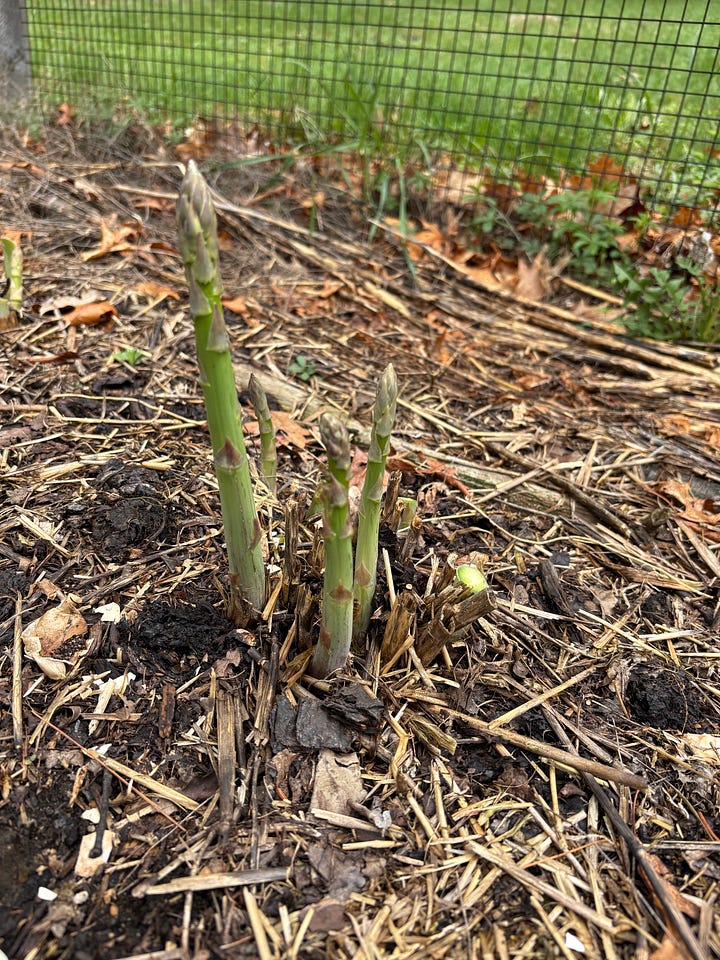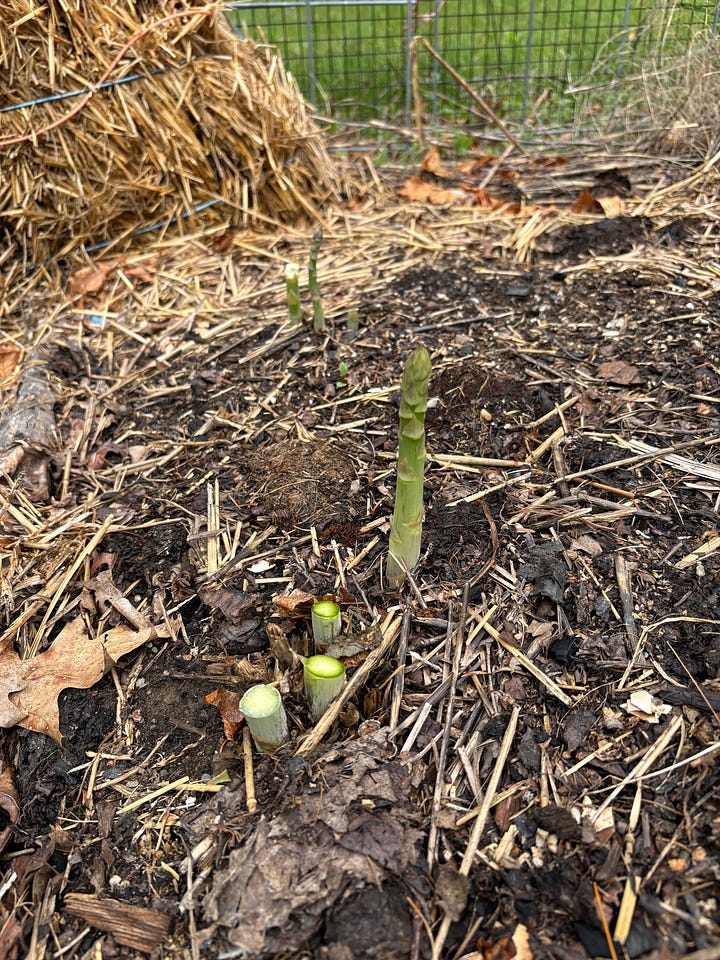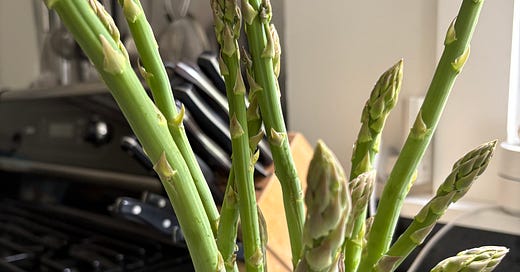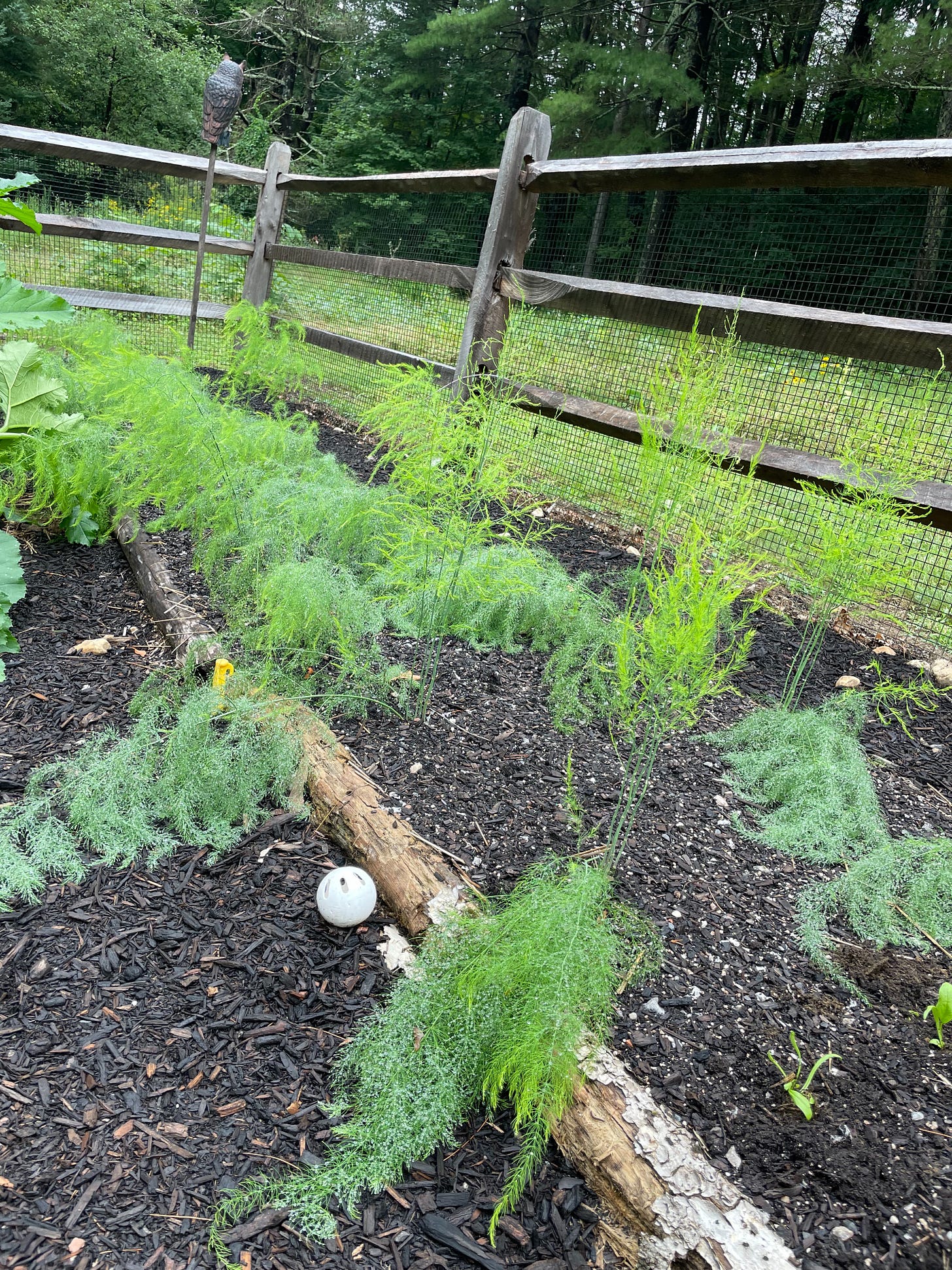Asparagus season is fleeting. So enjoy it.
We started an asparagus bed three years ago and this spring we're celebrating because it's finally mature enough to harvest.
We first experienced the joys of asparagus season when we lived in Europe years ago. The arrival of asparagus in England, Belgium, Germany, France and elsewhere on the continent heralded the beginning of spring and was celebrated with entire menus devoted to this lovely but fleeting vegetable.
The Germans absolutely loved white asparagus, which is grown underground to shield it from sunlight and prevent the development of chlorophyll but is almost identical in taste to its green cousin. Green or white, it was served simply, with chopped boiled eggs, a poached egg or a slice of ham, maybe with shaved parmesan cheese and a drizzle of olive oil on top, and almost always with a glass of crisp white wine or a cold beer. People ate it with their hands, grasping it lovingly between their fingertips before delicately consuming it.
For a few short weeks, it was everywhere. Then it was gone.
Katie and I are having our own asparagus-fest here in western Massachusetts this spring as we finally can indulge in the beautiful spears emerging from our asparagus bed. It’s been three years coming but worth the wait. In fact, now that we can actually harvest the spears for the first time we’re having trouble keeping up with them. Turn your back and a half-dozen or more stalks will present themselves literally overnight.
Growing asparagus, like gardening more broadly, will alter your appreciation of time. Building and planting a bed for a vegetable you won’t be able to enjoy for three years can test your resolve. It’s an investment in the future but can be difficult to endure in the present. And yet it condenses time as well, which is both disorienting and kind of alarming. The day we created our asparagus bed could have been last week, not the fall of 2022.
We started off by mapping out a large enough area in the vegetable garden for about 20 asparagus plants but not so large that it would take up space we wanted to devote to other plants. Ours measured 18 feet long by 3 feet wide. We added shredded oak leaves, compost and pine needles to help lower the soil pH, which ideally should be between 6.0 and 6.8 for asparagus. We then stepped away, the bed empty, and let winter run its course.

By the following spring we were ready to plant. It was Memorial Day weekend and we eagerly unpacked a cardboard box carrying 20 bare-root asparagus crowns that had arrived from Gurney’s Seed & Nursery in Indiana. They each looked a bit like a shriveled octopus, pale white with a central crown and long, spidery legs. We chose a variety called Jersey Knight, which is recommended for its resistance to disease and high productivity.
We planted them. And then we waited.
The bed came alive in the summer of 2023, as several modest asparagus ferns rose from the ground and graced the eastern end of the vegetable garden with their featherly bright green. Our interaction with the asparagus bed was limited to admiring it and imagining what we could not see, the root system expanding and strengthening beneath the soil, powered by the sun’s energy captured by the swaying ferns.
Last summer was different. In April 2024 dozens of real, honest, thick asparagus spears began rising from the bed, coyly beckoning us to pick them. Except for one stalk, which we shared raw, we resisted. The spears turned to ferns, which grew upwards of eight feet tall, gracing and overwhelming the eastern end of the garden. I put up stakes and ran twine between them down the rows to keep some order and allow us to make our way past.
This is how it goes when establishing an asparagus bed. For the first two years you want to let the plants grow as many ferns as they can without depleting them by picking them as young stalks. Once established a bed will produce asparagus for two decades or more.
This year, on cue, I noticed the first asparagus stalks emerging from the winter leaf and straw cover almost on the same day as a year ago. Only this spring we’ve been cutting and snapping the spears off and carrying them into the kitchen. The bed’s not fully mature yet, so we’ll limit our harvesting to just a couple weeks. Next spring, all bets are off. In the Northeast, asparagus beds will produce from late April through at least the end of May before you allow the spears to turn to ferns and resume the cycle.


At the moment, we have more than enough fresh asparagus for ourselves and some lucky neighbors.
Asparagus is best eaten fresh and while it may be cliche, there really is nothing like freshly picked asparagus for tenderness and flavor. Connoisseurs say thicker stalks, maybe the width of your thumb, are more tender than thin stalks. We get a mix of both and can’t tell the difference. I’ve taken to storing them in bunches of a dozen or so in a glass filled with water, the cut ends down, which seems to help maintain the freshness.
Now the challenge is coming up with enough ways to cook it. In recent years we’ve tended to roast asparagus in the oven or cook it over the grill, lightly coated with olive oil and sprinkled with salt. It’s wonderful that way, but the charring and roasting can overpower the flavor, at least when the asparagus is so tender it can be eaten raw.
We’ve poached the spears a few times, laying them flat in a wide skillet filled with an inch or so of lightly salted water. They’re done in about three minutes, when they turn a magnificent bright green. We’ve drizzled them with an excellent extra virgin olive oil (Here’s a plug: It’s called Inez and is produced by our son Augustin and daughter-in-law Kelly at their olive grove in Santa Ynez, California). And we’ve added a dash or two of high-quality white Balsamic vinegar (a touch suggested by Gus). They literally melt in your mouth.
Before grilling vegetables became popular, poaching or steaming was the most widely used method for cooking asparagus. I’m reminded of the stovetop asparagus cooker in my parents' kitchen growing up. It was an enameled white metal, about the size of a small coffee percolator, and the spears stood straight up inside it, the tougher bottoms submerged in water, the more tender flowers steaming in the air.
So far we’ve had poached asparagus with grilled salmon and with a buttery French omelet, and lightly sauteed as part of a simple primavera sauce served over pasta. We may have to move on soon to an asparagus soup or an asparagus quiche, or using it as a topping for homemade pizza. We’ll probably even grill some.
Our appetite for this vegetable will certainly flag, and probably soon, which is just as well and maybe by design. The season lasts only a few short weeks, after all, so we’re trying to indulge ourselves while it lasts.
Here’s a selection of recent posts:
Ramptinis, or ramp foraging, Part II






Nice post Matt! Here in Maryland we’ve been enjoying asparagus from the farmers market and loads of spinach from the garden. I’ve taken to eating both steamed with just butter, salt and pepper, and rice vinegar. I used to love them with white balsamic, but have found that rice vinegar has a very light, clean flavor that really lets the taste of the vegetable shine. Give it a try!
When you store asparagus stalks in water, is that in a refrigerator or at room temperature?